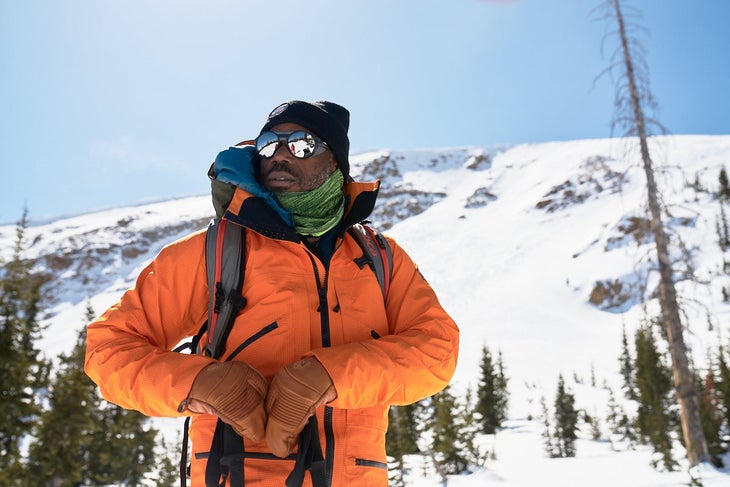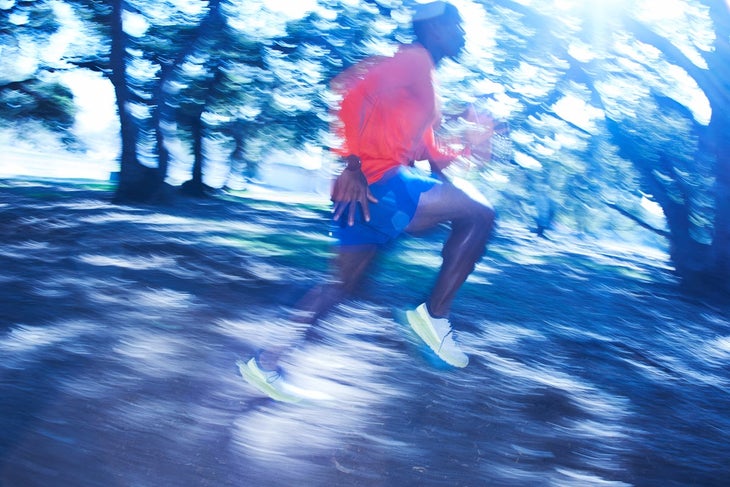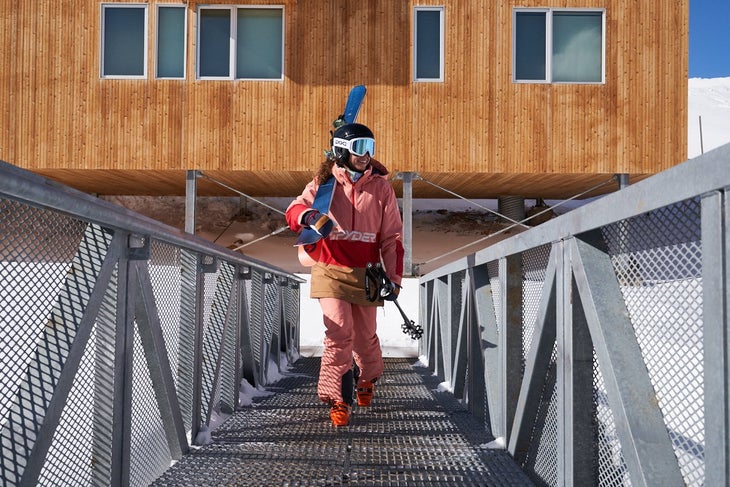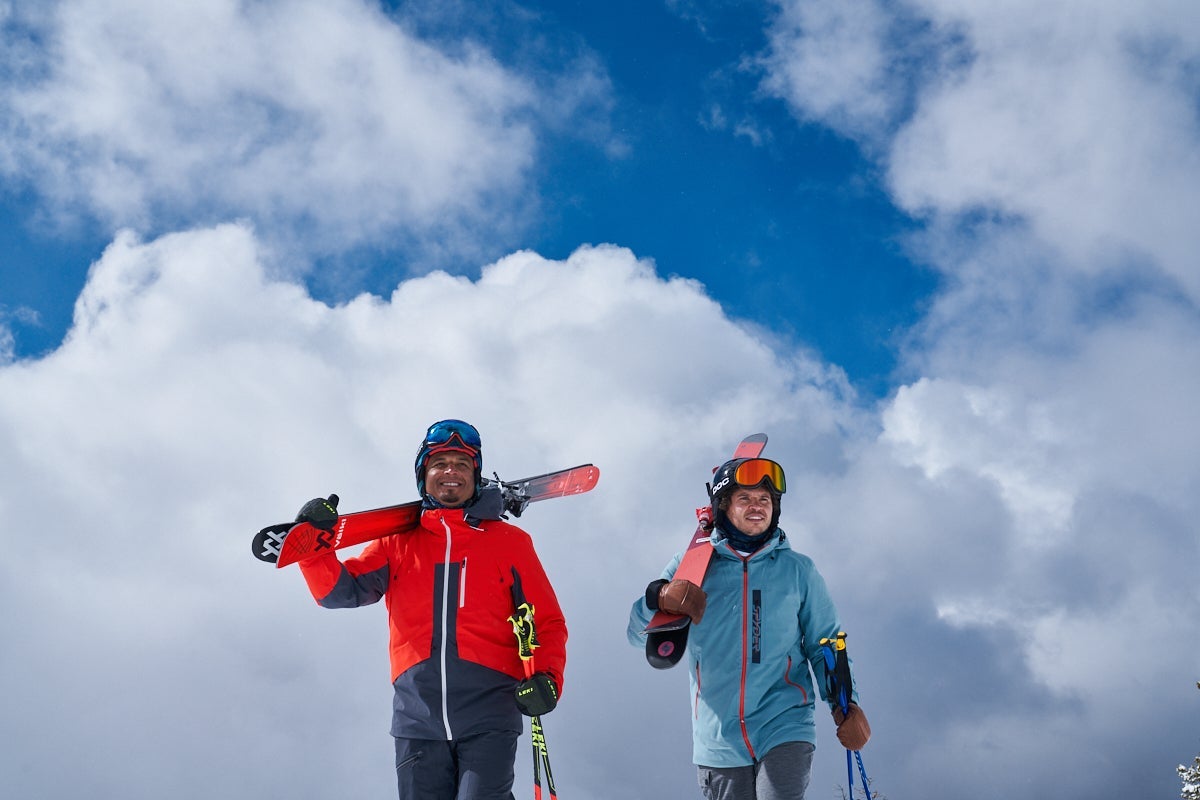This past March, SKI magazine hired me for a stock photo shoot at Utah’s Powder Mountain. In some ways, it was pretty standard—myself and three skiers, knocking off a laundry list of imagery: high speed carving shots, laughing while carrying skis shots, après shots…the usual. On the other hand, it was unlike any photo shoot ever done in the history of skiing.
That’s because all four of us are Black.
I’ve shot skiing and snowboarding for over 20 years, but this was only the second time I’ve done an all-Black shoot. The first was 20 years ago, when I organized an all-Black shoot with Keir Dillon, Ahmon Stamps, Damon Morris, and Ben Hinkley for Snowboarder. This time around, as with the first time, what struck me was the conversations we had during our time together. Being on the hill, setting marks and hitting them, creating the imagery—that’s that same as it ever was. But the discussions between shots, the places our conversations went in the evening over a meal—those are not things I’m used to talking about in this context.
Errol Kerr, the former X Games and Olympic skiercross competitor, was one of the skiers with me at Powder Mountain. In his 20 years of skiing, he’d never done a shoot with a single Black person, let alone three of us. We talked about the adversity his family went through to keep him on skis, what we’ve encountered when we’ve pushed for equity in the past, what made us feel bad, what made us feel good. It’s stuff that he’s kept mostly bottled up for his entire career.

The other two skiers were Justin and Lauren Samuels. Lauren, a former member of the U.S. Ski Team development squad, arrived at Powder Mountain in a similar position to a lot of BIPOC outdoor athletes: suddenly in high demand. Prior to the 2018 Winter Olympics, she consulted with and was talent on a Procter & Gamble shoot produced by Wieden + Kennedy. The two of us talked at length about the differences between commercial and editorial production—the pay rates, what’s fair, what’s not; what makes sense from a financial standpoint, and what needs to change from an inclusivity standpoint.
Rare as they are, shoots like these provide a crucial opportunity for BIPOC athletes and content creators, where we can compare notes and gut check the progress (or lack of it) that’s been made over the past year of racial reckoning in this industry.
Paying Up for BIPOC Talent
To understand how necessary this is, you only need to look back to this 2018 Subaru campaign. It features a formerly homeless San Diego teenager named Ryan Hudson, whose life turned around after a chance encounter with snowboarding. It’s an inspiring story, one on which Subaru undoubtedly spent significant money, judging from the video’s production value. According to Hudson, however, he didn’t see any of it.
Typically in a production of this caliber, someone in Hudson’s role is compensated; at a minimum, a charitable donation is made to the cause they represent. But he was still learning the business of how outdoor sports are marketed. Three years later, he’s mentored with Conrad Anker and climbed Denali with Jon Krakauer. Hudson now knows the questions he needs to ask before committing to a campaign, but the brands often still don’t know the right questions to ask him in order to leverage his insight and put his strengths to work for them.

In 2018, brands could treat BIPOC talent differently and find savings by taking advantage of what that talent didn’t know to ask for. Now, talent like Lauren is the rare expert in a scenario with extreme demand. It’s a seller’s market and she’s the seller.
The Scramble for Diverse Talent
In the wake of the Black Lives Matter movement following George Floyd’s murder, brands everywhere scrambled to find Black athlete and influencers—people like Lauren—to feature in their campaigns. It was like a bunch of brands looking to pull carrots while realizing they never planted any seeds. Lauren and her peers were pulled in all these different directions by brands that don’t understand what they’re doing or why they’re doing it.
The sudden investment by the outdoor industry in BIPOC athletes, influencers, and content creators might be a trend for some brands, but for the smart ones, it’s a sea change. VF Corp didn’t lay out two billion dollars for Supreme just because it liked the optics of supporting street culture; it was a healthy bet on a future in which authentic diversity is the new key to the kingdom.
It was smart; instead of buying pieces of the machine and trying to assemble it into some imitation of “the culture,” they just bought the whole factory. On the other end of the spectrum, Black designers and entrepreneurs are already circling the outdoor industry. Watch what Virgil Abloh with Off White or Kerby Jean Raymond with Pyer Moss do over the next few years, and see how long it takes them to reset the deck in outerwear.
Meanwhile, everyone else in the outdoor industry will need to decide: are they just going to pay some hip hop star to go snowboarding in their gear, or are they going to develop meaningful relationships with content producers and brand ambassadors and allow them to guide these companies toward a more inclusive future?
I’m all for creating new experiences and buzz with celebrities as long as that exponential value and respect is also shown to veterans like Phil Henderson—people who fought through adversity for advocacy and equality in the outdoors for years before it was on brand.
Brands who engage with this effort in good faith might be surprised by who they find on the other side of the table. It may not be the kid who can huck the biggest air or who has the largest Instagram following. They might bring a sensibility that’s informed by stick and ball-style deal-making and pop culture-influenced brand building. Maybe these kids model how LeBron James’ SpringHill Entertainment, Ava DuVernay’s Array, or Tyler Perry Studios do business. However they come at it, it will look different than what many outdoor brands are used to dealing with.
There’s a long game here, business-wise. Sometime in the next 20 to 30 years, groups formerly seen as “minorities” will become the majority. Brands who engage in good faith and allow themselves to learn will earn loyalty from a consumer base that knows virtue signaling when they see it and will spend their dollars with brands in which they believe.
A Checklist: Is Your Company Doing the Work?
To all the companies out there that want to contribute to a more diverse and equitable outdoors, I have bad news and good news. The bad news is that this will be uncomfortable at times. The good news is that you can prepare for that now by doing internal work that leads to external validations. Consider:
- Has your brand conducted an independent audit of how diverse your workforce is? Did you share the results, both internally and externally? Have you committed to specific goals that move the needle going forward? The New York Times is a great example of a company that’s doing this well.
- Have you implemented DEI training on topics like unconscious bias for your workforce, and identified ways to ensure your company culture is welcoming to the more diverse workforce you’re hoping to attract?
- If your brand is already working on these kinds of initiatives, how well funded are they? It’s good to have C-suite buy-in for these initiatives, but who ultimately approves the spend? Does your CFO back them as essential?
- When your brand creates products or services that touch on minority culture, does part of the profit go to these communities? Has your brand committed any percentage of its annual marketing spend to BIPOC-owned media?
- When your brand engages BIPOC athletes, influencers, and ambassadors, are they compensated competitively? Are creators like myself, who require brands to treat the talent and crew I work with equitably, embraced or avoided?
The most interesting conversation I had at Powder Mountain wasn’t with Errol or Lauren or Justin; it was with Lauren’s father, David, who came along just to see something he never thought he would: an all-Black ski shoot.

Mr. Samuels is basically the Black MacGyver, an unsung outdoor industry veteran from the ’80s and ’90s who worked his way from sales rep for Salomon to senior director of new product Innovation with Rollerblade. The guy has done so many cool things, but what struck me most was his pure and sincere love of the outdoors—and the way he instilled that same love in his kids.
That generational love has always driven the outdoor industry; the consumer base has been so homogenous for so long because we’ve made incorrect assumptions about who might share that love. Challenging these assumptions—whether by how you market, who you market with, or how you engage those people to whom you’re marketing—is the first step toward a more diverse and equitable outdoor industry.


